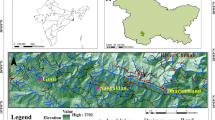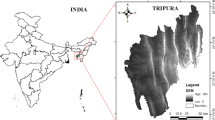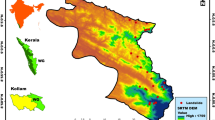Abstract
This research work presents a comparative performance of geographic information system (GIS)-based statistical models for landslide susceptibility mapping (LSM) of the Himalayan watershed in India. A total of 190 landslide locations covering an area of 14.63 km2 were identified in the watershed, using high-resolution linear imaging self-scanning (LISS IV) data. The causative factors used for LSM of the study area are slope, aspect, lithology, curvature, lineament density, land cover and drainage buffer. The spatial database has been prepared using remote sensing data along with ancillary data like geological maps. LSMs were prepared using information value (InV), frequency ratio (FR) and analytical hierarchy process (AHP) models. The validation results using the prediction rate curve technique show 89.61%, 87.12% and 88.26% area under curve values for FR, AHP and InV models, respectively. Therefore, the frequency ratio (FR) model could be used for LSM in other parts of this hilly terrain.








Similar content being viewed by others
References
Achour Y, Boumezbeur A, Hadji R, Chouabbi A, Cavaleiro V, Bendaoud EA (2017) Landslide susceptibility mapping using analytic hierarchy process and information value methods along a highway road section in Constantine, Algeria. Arab J Geosci 10 (194). https://doi.org/10.1007/s12517-017-2980-6
Aleotti P, Chowdhary R (1999) Landslide hazard assessment: summary, review and new perspectives. Bull Eng Geol Environ 58:21–44
Ambraseys N, Bilham R (2000) A note on the Kangra M s= 7.8 earthquake of 4 April 1905. Curr Sci 79(1):45–50
Anabalgan R, Singh B (1996) Landslide hazard and risk assessment mapping of mountainous terrains- a case study from Kumaun Himalaya, India. Eng Geol 43:237–246. https://doi.org/10.1016/S0013-7952(96)00033-6
Anabalgan R, Chakraborty D, Kohli A (2008) Landslide hazard zonation mapping on meso scale for systematic planning in mountainous terrain. J Sci Ind Res 67:486–497
Anbalagan R, Kumar R, Lakshmanan K, Parida S, Neethu S (2015) Landslide hazard zonation mapping using frequency ratio and fuzzy logic approach, a case study of Lachung Valley, Sikkim. Geoenviron Disasters 2(1):1–17. https://doi.org/10.1186/s40677-014-0009-y
Ayalew L, Yamagishi H (2005) The application of GIS based logistic regression for landslide susceptibility mapping in the Kakuda-Yahiko mountains Central Japan. Geomorphology 65(1):15–31. https://doi.org/10.1016/j.geomorph.2004.06.010
Ayalew L, Yamagishi H, Ugawa N (2004) Landslide susceptibility mapping using GIS based weighted linear combination, the case in Tsugawa area of Agano river, Niigata Perfecture, Japan. Landslides 1:73–81
Bijukchhen P, Kayastha P, Dhital MR (2013) A comparative evaluation of heuristic and bivariate statistical modelling for landslide susceptibility mappings in Ghumri-Dhad Khola, East Nepal. Arab J Geosci 6:2727–2743. https://doi.org/10.1007/s12517-0569-7
Cardinali M, Galli M, Guzzetti F, Ardizzone F, Reichenbach P, Bartoccini P (2006) Rainfall induced landslide in December 2004 in South-Western Umbria, Italy: types, extent, damage and risk assessment. Nat Hazard Earth Syst Sci 6:237–260 http://www.nat-hazards-earth-syst-sci.net/6/237/2006
Chen T, Niu R, Jia X (2016) A comparison of information value and logistic regression models in landslide susceptibility mapping by using GIS. Environ Earth Sci 75:867. https://doi.org/10.1007/s12665-016-5317-y
Cruden DM (1991) A simple definition of a landslide. Bull Int Assoc Eng Geol 43:27–29
Dahal RK, Hasegawa S, Nonomura A, Yamanaka M, Dhakal S, Paudyal P (2008) Predictive modelling of rainfall induced landslide hazard in lesser Himalaya of Nepal based on weight of evidence. Geomorphology 102:496–510
Dahal RK, Hasegawa S, Bhandary NP, Poudel PP, Nonomura A, Yatabe Y (2012) A replication of landslide hazard mapping at catchment scale. Geomat Nat Hazards Risk. https://doi.org/10.1080/19475705.2011.629007
Dai FC, Lee CF (2002) Landslide characteristics and slope instability modelling using GIS, Lantau Island, Hong Kong. Geomorphology 42:213–238
Das I, Stein A, Kerle N, Dhadwal VK (2012) Landslide susceptibility mapping along road corridors in the Indian Himalayas using Bayesian logistic regression models. Geomorphology 179:116–125. https://doi.org/10.1016/j.geomorph.2012.08.004
Fell R, Corominas J, Bonnard C, Cascini L, Leroi E, Savage WZ (2008) Guidelines for landslide susceptibility, hazard and risk zoning for land-use planning. Eng Geol 102(3):99–111. https://doi.org/10.1016/j.enggeo.2008.03.014 Geomorphology 102:496–510. DOI 10.1016/j.geomorph.2008.05.041
Ghosh S, Carranza EJM, Van Westen CJ, Jetten V, Bhattacharya DN (2011) Selecting and weighting spatial predictors for empirical modeling of landslide susceptibility in the Darjeeling Himalaya (India). Geomorphology 131:35–56. https://doi.org/10.1016/j.geomorph.2011.04.019
Gupta RP, Saha AK, Arora MK, Kumar A (1999) Landslide hazard zonation in a part of Bhagirathi Valley, Gharwal Himalaya, using integrated remote sensing and GIS. J Him Geol 20:71–85
Gupta RP, Kanungo DP, Arora MK, Sarkar S (2008) Approaches for comparative evaluation of raster GIS-based landslide susceptibility zonation maps. Int J Appl Earth Obs Geoinf 10:330–341. https://doi.org/10.1016/j.jag.2008.01.003
Guzzetti F, Reichenbach P, Cardinali M, Galli M, Ardizzone F (2005) Probabilistic landslide hazard assessment at the basin scale. Geomorphology 72:272–299. https://doi.org/10.1016/j.geomorph.2005.06.002
Hadji R, Errahmane Boumazbeur A, Limani Y, Baghem M, el Madjid Chouabi A, Demdoum A (2013) Geologic, topographic and climatic controls in landslide hazard assessment using GIS modeling: a case study of Souk Ahras region, NE Algeria. Quat Int 302:224–237. https://doi.org/10.1016/j.quaint.2012.11.027
Kayastha P, Dhital MR, De Smedt F (2012) Evaluation of the consistency of landslide susceptibility mapping: a case study from the Kankai watershed in East Nepal. Landslides 10:785–799. https://doi.org/10.1007/s10346-012-0361-5
Kayastha P, Dhital MR, De Smedt F (2013) Application of the analytical hierarchy process (AHP) for landslide susceptibility mapping: a case study from Tinau watershed, West Nepal. Comput Geosci 52:398–408. https://doi.org/10.1016/j.cageo.2012.11.003
Komac M (2006) A landslide susceptibility model using the analytical hierarchy process method and multivariate statistics in perialpine Slovenia. Geomorphology 74:17–28. https://doi.org/10.1016/j.geomorph.2005.07.005
Kumar R, Anabalgan R (2016) Landslide susceptibility mapping using analytical hierarchy process (AHP) in Tehri reservoir rim region, Uttarakhand. J Geol Soc India 87:271–286
Kumar S, Mahajan AK (1991) Dharamsala Seismotectonic zone-Neotectonics and state of stress in the area. J Himal Geol 2(1):53–57
Kumar S, Mahajan AK (2001) Seismotectonics of the Kangra region, northwest Himalaya. Tectonophysics 331(4):359–371
Kumar KV, Nair RR, Lakhera RC (1993) Digital image enhancement for delineating active landslide areas. Asia-Pac Remote Sens J 6(1):63–66
Lee S, Min K (2001) Statistical analysis of landslide susceptibilityat Yongin, Korea. Environ Geol 40:1095–1113
Lee S, Pradhan B (2006) Probabilistic landslide hazard and risk mapping on Penang Island, Malaysia. J Earth Syst Sci 115(6):661–672
Lee S, Pradhan B (2007) Landslide hazard mapping at Selangor, Malaysia using frequency ratio and logistic regression models. Landslides 4:33–41. https://doi.org/10.1007/s10346-006-0047-y
Lee S, Talib JA (2005) Probabilistic landslide susceptibility and factor effect analysis. Environ Geol 47:982–990. https://doi.org/10.1007/s00254-005-1228-z
Lee S, Ryu JH, Kim IS (2007) Landslide susceptibility analysis and its verification using likelihood ratio, logistic regression and artificial neural network models: case study of Youngin, Korea. Landslides 4(4):327–338. https://doi.org/10.1007/s10346-007-0088-x
Lee S, Hwang J, Park I (2013) Application of data driven evidential belief functions to landslide susceptibility mapping in Jinbu, Korea. Catena 100:15–30. https://doi.org/10.1016/j.catena.2012.07.01
Mahajan AK, Kumar S (1994) Linear features registered on the Landsat Imagery in the Dharamsala-Palampur area NW Himalaya, vis-à-vis seismic status of the area. Geophysika II:15–25
Mahajan AK, Virdi NS (2000) Preparation of landslides hazard zonation map of Dharamshala town & adjoining areas. District Kangra (H.P.): technical report, Wadia institute of Himalayan Geology, Dehradun, ref No. Endst/281/MA dt 27/2/99, pp 45
Mathew J, Jha VK, Rawat GS (2007) Weight of evidence modelling for landslide hazard zonation mapping in part of Bhagirathi valley, Uttarakhand. Curr Sci 92(5):628–638
Melo R, Vieira G, Caselli A, Ramos M (2012) Susceptibility modelling of hummocky terrain distribution using the information value method (Deception Island, Antarctic peninsula). Geomorphology 155:88–95. https://doi.org/10.1016/j.geomorph.2011.12.027
Pachauri AK, Pant M (1992) Landslide hazard mapping based on the geological attributes. Eng Geol 32:81–100
Pradhan B (2010) Application of an advanced fuzzy logic model for landslide susceptibility analysis. Int J Comput Intel Sys 3(3):370–381
Pradhan B, Lee S (2010) Regional landslide susceptibility analysis using back-propagation neural network model at Cameron Highland, Malaysia. Landslides 7(1):13–30. https://doi.org/10.1007/s10346-009-0183-2
Pradhan B, Sezer E, Gokceoglu C, Buchroithner MF (2010) Landslide susceptibility mapping by neuro-fuzzy approach in a landslide prone area (Cameron Highland, Malaysia). IEEE T Geosci Remote 48(12):4164–4177. https://doi.org/10.1109/TGRS.2010.2050328
Rai PK, Mohan K, Kumar VK (2014) Landslide hazard and its mapping using remote sensing and GIS. J Sci Res BHU 58 ISSN 0447-9483
Rasyid AR, Bhandary NP, Yatabe R (2016) Performance of frequency ratio and logistic regression model in creating GIS based landslides susceptibility map at Lompobattang Mountain, Indonesia. Geoenviron Disas 3:19. https://doi.org/10.1186/s40677-016-0053-x
Rawat MS, Uniyal DP, Dhobal R, Joshi B, Rawat BS, Bartwal A, Singh D, Aswal A (2015) Study of landslide hazard zonation in Mandakini valley, Rudraprayag district, Uttarakhand, using remote sensing and GIS. Curr Sci 109(1):158–170
Rozos D, Bathrellos GD, Skilodimou HD (2011) Comparison of the implementation of rock engineering system and analytical hierarchy process methods, based on landslide susceptibility maps, compiled in GIS environment. A case study from eastern Achaia county of Peloponnesus, Greece. Environ Earth Sci 63(1):49–63. https://doi.org/10.1007/s12665-010-0687-z
Saaty TL (1980) The analytical hierarchy process. McGraw Hill, Pittsburgh
Saaty TL (1990) How to make a decision: analytical hierarchy process. Eur J Oper Res 48:9–26
Saaty TL (2005) Theory and application of the analytic network process. RWS, Pittsburg
Saaty TL, Vargas LG (2001) Models, methods, concepts and application of analytical hierarchy process. Kluwer, Boston, p 333
Sah MP, Srivastava RAK (1992) Morphology and facies of the alluvial-fan sedimentation in the Kangra Valley, Himachal Himalaya. Sediment Geol 76(1):23–42
Saha AK, Gupta RP, Arora MK (2002) GIS-based landslide hazard zonation in a part of the Himalayas. Int J Rem Sens 23(2):357–369
Saha AK, Gupta RP, Sarkar I, Arora MK, Csaplovics E (2005) An approach for GIS based statistical landslide zonation with a case study in the Himalaya. Landslides 2:61–69. https://doi.org/10.1007/s10346-004-0039-8
Sarkar S, Kanungo DP (2004) An integrated approach for landslide susceptibility mapping using remote sensing and GIS. Photo Eng. and remote sensing 70:617–625
Sarkar S, Kanungo DP, Patra AK, Kumar P (2008) GIS based landslide susceptibility mapping- a case study in Indian Himalaya. Proc Interpraevent Int Symp on Disaster mitigation of debris flows, slope failures and landslides: 617–624
Sarkar S, Roy AK, Martha TR (2013) Landslide susceptibility assessment using information value method in parts of the Darjeeling Himalayas. J Geol Soc India 82:351–362
Shahabi H, Hashim M (2015) Landslide susceptibility mapping using GIS based statistical models and remote sensing data in tropical environment. Sci Rep 5:9899. https://doi.org/10.1038/srep09899
Sharma R, Sharma UK, Mahajan AK (2015) Rainfall and anthropologically accelerated mass movement in the outer Himalaya, north of Dharamshala town, Kangra district, Himachal Pradesh: a cause of concern. J Geol Soc India 86(5):563–569
Shirzadi A, Chapi K, Shahabi H, Solaimani K, Kavian A, Ahmad BB (2017) Rock fall susceptibility assessment along a mountainous road: an evaluation of bivariate statistic, analytical hierarchy process and frequency ratio. Environ Earth Sci 76(4):152. https://doi.org/10.1007/s12665-017-6471-6
Singh K, Kumar V (2017) Landslide hazard mapping along national highway-154A in Himachal Pradesh, India using information value and frequency ratio. Arab J Geosci 10(24):539
Singh TN, Gulati A, Dontha IK, Bhardwaj V (2008) Evaluating cut slope failure by numerical analysis- a case study. Nat Hazards 47:263–279. https://doi.org/10.1007/s11069-008-9219-5
Van Westen CJ (1993) Application of geographic information systems to landslide hazard zonation. Doctoral dissertation, TU Delft, Delft University of Technology
Van Westen CJ (1994) GIS in landslide hazard zonation: a review with examples from the Colombian Andes. In: Price MF, Heywood DI (eds) Mountain environments and geographic information systems. Taylor and Francis, London, pp 135–165
Van Westen CJ, Van Asch TW, Soeters R (2006) Landslide hazard and risk zonation—why is it still so difficult? Bull Eng Geol Environ 65(2):167–184. https://doi.org/10.1007/s10064-005-0023-0
Van Westen CJ, Castellanos E, Kuriakose SL (2008) Spatial data for landslide susceptibility, hazard and vulnerability assessment: an overview. Eng Geol 102:3–4. https://doi.org/10.1016/j.enggeo.2008.03.010
Varnes DJ (1978) Slope movement types and processes. Spec Rep 176:11–33
Varnes DJ (1984) Landslide hazard zonation: a review of principles and practice, natural hazard 3, commission on landslides of the IAEG. UNESCO, Paris
Xu C, Xu X, Dai F, Wu Z, He H, Shi F, Wu X, Xu S (2013) Application of an incomplete landslide inventory, logistic regression model and its validation for landslide susceptibility mapping related to may 12, 2008 Wenchuan earthquake of China. Nat Hazards 68:883–900. https://doi.org/10.1007/s11069-013-0661-7
Yalcin A, Reis S, Aydinoglu AC, Yomralioglu T (2011) A GIS based comparative study of frequency ratio, analytical hierarchy process, bivariate statistics and logistic regression methods for landslide susceptibility mapping in Trabzon, NE Turkey. Catena 85(3):274–287. https://doi.org/10.1016/j.catena.2011.01.014
Yin KL, Yan TZ (1988) Statistical prediction model for slope instability of metamorphosed rocks. In: Bonnard, C (ed) Proceedings of the 5th international symposium on landslides, Lausanne Balkema, Rotterdam, pp 1269–1272
Zhou G, Esaki T, Mitani Y, Xie M, Mori J (2003) Spatial probabilistic modeling of slope failure using an integrated GIS Monte Carlo simulation approach. Eng Geol 68(3):373–386. https://doi.org/10.1016/S0013-7952(02)00241-7
Acknowledgements
Authors are grateful to the Department of Science and Technology (DST) for providing a research grant under project no. NRDMS/11/3023/013(G) for carrying out the studies. The authors also gratefully acknowledge the administrative and logistic support provided by the respective head of the Institutions. The suggestions from the reviewers for improvement of this research work is highly acknowledged by the authors.
Author information
Authors and Affiliations
Corresponding author
Rights and permissions
About this article
Cite this article
Sharma, S., Mahajan, A.K. A comparative assessment of information value, frequency ratio and analytical hierarchy process models for landslide susceptibility mapping of a Himalayan watershed, India. Bull Eng Geol Environ 78, 2431–2448 (2019). https://doi.org/10.1007/s10064-018-1259-9
Received:
Accepted:
Published:
Issue Date:
DOI: https://doi.org/10.1007/s10064-018-1259-9




